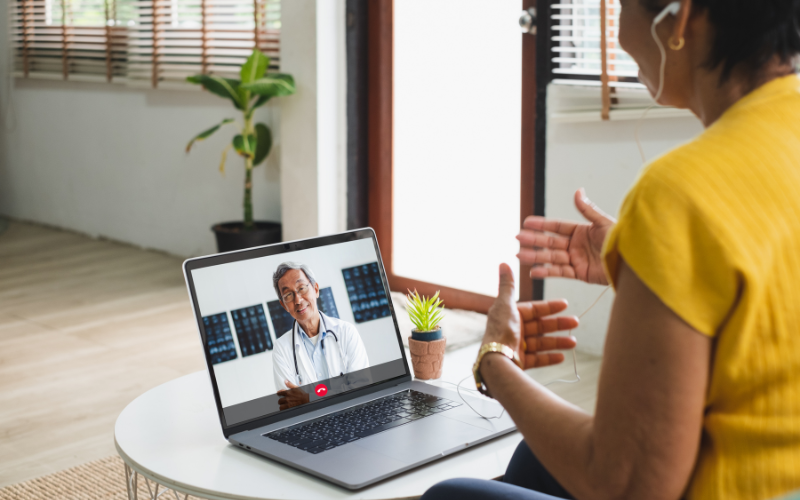Telehealth has transformed the healthcare landscape, and providing virtual medical care is now a regular occurrence for many practitioners. While in-person sessions at simulation labs are an ideal learning environment for building clinical, interpersonal, and tech-based skills, how can healthcare practitioners be better prepared for the world of virtual medicine?

The answer lies in remote encounters with standardized patients (SPs), which allow providers to practice technical skills, improve online communication techniques, and adapt to the unique demands of virtual consultations. Studies even suggest that telehealth simulations with standardized patients are just as effective for developing learner competency and preparedness as face-to-face encounters.
Developing Skills for Telehealth Success
As providers and patients embrace telehealth, educators and program developers must meet growing training needs. New guidelines for educators emphasize the benefits of using virtual simulations with standardized patients to teach telehealth skills. The guidelines cover everything from simulation design and technology requirements to care delivery and debriefing.
A collaborative study between C‐TIER (Center for Telehealth, Innovation, Education, and Research) and SP‐ed, our innovative web-based platform specializing in remote standardized patient learning, further demonstrates the value of virtual SP sessions for telehealth training.
Authors Tina Gustin, DNP, CSN RN, and Steven Haimowitz, MD, reported that 94% of participant learners agreed their digital SP session was at least equally or more helpful than face-to-face SP encounters. All participants agreed or strongly agreed that their remote SP session was “helpful in improving their overall telehealth skills.” The study supports the inclusion of virtual SP sessions in telehealth curricula, demonstrating that it is a practical and effective learning method.
What other benefits can providers expect when practicing telehealth skills using remote simulations?
1. Gain Familiarity with Technology
One of the critical aspects of telehealth is the technology involved. Remote simulations help providers practice setting up video calls, troubleshooting basic platform or device issues, and even the nuances of managing how they look and sound on a video call. Experience with the technology can help prevent disruptions during virtual visits, improve patient satisfaction, and enhance quality of care.
While the specific software used in telehealth and remote simulations may differ based on the institution, these steps and skills are often transferable. Providers can gain familiarity with a more technological approach to healthcare, including everything from network and device requirements to obtaining a backup phone number in case of tech disruptions.
Telehealth simulation labs provide a safe environment for providers to implement telehealth best practices such as HIPAA compliance and gaining consent without putting actual patients at risk. Maintaining patient data security using secure systems, maintaining the privacy of patient information, and complying with privacy laws are essential skills for telehealth service delivery.
2. Practice Virtual Communication
Communicating with patients online requires skills different from those needed for in-person interactions. Orienting the patient and introducing yourself properly may feel different in a virtual setting, and nonverbal cues may be less apparent. In telehealth simulations, providers can learn to read body language and facial expressions through the camera.
Virtual sessions help providers practice telehealth etiquette and communicate effectively without relying on a full-body visual to interpret body language. Remote simulation labs with SPs also allow providers to practice active listening, empathy, and other essential techniques for building rapport and trust.
3. Hone Clinical Reasoning
Digital tools provide accessible, repeatable opportunities for providers to interact with complex cases and patient variety, sharpen their clinical reasoning skills, and improve their diagnostic accuracy. Virtual learning tools “lower the barrier to building knowledge” and supplement traditional education practices.
Practicing the cognitive process of instructing patients to self-examine is crucial, too. Taking thorough patient histories, obtaining data from a patient’s self-conducted physical exams, and considering electronic data from smartwatches and home scales allows the clinician to gather information and implement clinical reasoning to recommend appropriate next steps
4. Develop Culturally Competent and Inclusive Care
Telehealth effectively eliminates geographical barriers and logistical challenges associated with in-person care. It also helps address systemic imbalances. This benefit is significant for patients with difficulty traveling to appointments or finding local specialists. Patients can access inclusive healthcare regardless of location, home-bound status, mobility, background, or other limiting factors.
As a result, a larger pool of providers and patients come together in a virtual space to cooperate in medical care and decision-making. Providers will likely encounter a more diverse patient demographic virtually than in the clinic.
Virtual SP sessions mirror the accessibility of telehealth and extend beyond the boundaries of location and time zone. Remote simulations equip providers with the skills to offer inclusive, equitable care.
Remote simulations are revolutionizing telehealth training, offering healthcare providers the skills they need to excel in virtual care. Sessions with virtual standardized patients reflect the same skill set used in telehealth.
Simclusive’s easy-to-use, on-demand platform and expertly trained team of remote standardized patients give learners, educators, and curricula developers tools for otherwise undersupported clinical training areas. From mastering technology to building inclusive care practices, our patient scenarios are a valuable supplement to clinical training that is both effective and accessible.
Contact Simclusive to transform your telehealth service delivery and take your practice from the exam room to any room.

